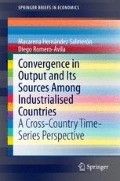Abstract
This chapter outlines the empirical framework and the main variables involved in the analysis of stochastic and deterministic convergence. It then describes the data source used and the exact data series employed to measure real output per worker, real physical capital per worker, human capital, total factor productivity (TFP) and average annual hours worked. As regards the data source, we employ the newest version of the so-called Penn World Table, version 8.0. As measures of real GDP, real physical capital and TFP, we employ the series based on national-accounts data. As for the measure of human capital, we employ the Psacharopoulos (1994) survey of wage equations evaluating the returns to education that transforms average years of schooling data into a human capital index.
Access this chapter
Tax calculation will be finalised at checkout
Purchases are for personal use only
Notes
- 1.
As shown below, for the computation of the TFP series, Inklaar and Timmer (2013) approximate these output elasticities by assuming perfect competition in factor and good markets. This allows to consider α as the share of GDP not earned by labor.
- 2.
We include average annual hours worked in our convergence analysis because the production function could be written in terms of per hour worked rather than in per worker terms.
- 3.
β-convergence implies that countries starting from a high income level are expected to exhibit lower income growth than countries beginning with low income levels. The terms conditional and unconditional (absolute) refer to whether convergence takes place after controlling or not for country-specific characteristics, which can account for differences in steady state income levels.
- 4.
Bernard and Durlauf (1996) further demonstrate that a negative cross-section relationship between initial income and growth is compatible with a class of structural models which violate the time series definition of convergence implied by the equality of long-term forecasts of per capita output for two countries at a fixed time. Along similar lines, Quah (1993) shows that the existence of β-convergence is compatible with a stable cross-section variance in output levels.
- 5.
The data are accessible from www.ggdc.net/pwt.
- 6.
See Badunenko and Romero-Ávila (2013, 2014) for other studies employing a similar definition of human capital.
- 7.
The time span investigated begins in 1970 because Germany did not have data on employment, TFP and average annual hours worked before that year.
Author information
Authors and Affiliations
Corresponding author
Rights and permissions
Copyright information
© 2015 The Author(s)
About this chapter
Cite this chapter
Hernández-Salmerón, M., Romero-Ávila, D. (2015). Model Specification and Data. In: Convergence in Output and Its Sources Among Industrialised Countries. SpringerBriefs in Economics. Springer, Cham. https://doi.org/10.1007/978-3-319-13635-6_2
Download citation
DOI: https://doi.org/10.1007/978-3-319-13635-6_2
Published:
Publisher Name: Springer, Cham
Print ISBN: 978-3-319-13634-9
Online ISBN: 978-3-319-13635-6
eBook Packages: Business and EconomicsEconomics and Finance (R0)

